#map of caspian sea and countries
Text
2,500 dead Caspian seals found off Russian coast
2,500 dead Caspian seals found off Russian coast
Credit image – theSpec.com
About 2,500 seals have been found dead off the coast of the Caspian Sea in southern Russia, officials said Sunday. Local authorities initially reported on Saturday that 700 dead seals were found on land, but the Russian Ministry of Natural Resources and Ecology later raised that number to around 2,500. Local authorities in Russian Dagestan said it was unclear why the…

View On WordPress
#2#500 dead Caspian seals found off Russian coast#500 dead seals found on russia&039;s caspian coast#caspian#caspian sea#caspian sea map#caspian seal#map of caspian sea and countries#map of the caspian sea#map of the caspian sea and surrounding countries#map of the caspian sea area#mysterious discoveries found on the beach#Russia#russia warships caspian black sea ukraine#russian#russian geography#russian reacts to russia#the caspian sea
0 notes
Text
Hey All,
I've been away for some time, as we've been working really hard on something quite exciting:
let me present to you the world's first ever global ocean drainage basin map that shows all permanent and temporary water flows on the planet.

This is quite big news, as far as I know this has never been done before. There are hundreds of hours of work in it (with the data + manual work as well) and it's quite a relief that they are all finished now.
But what is an ocean drainage basin map, I hear most of you asking? A couple of years ago I tried to find a map that shows which ocean does each of the world's rivers end up in. I was a bit surprised to see there is no map like that, so I just decided I'll make it myself - as usual :) Well, after realizing all the technical difficulties, I wasn't so surprised any more that it didn't exist. So yeah, it was quite a challenge but I am very happy with the result.
In addition to the global map I've created a set of 43 maps for different countries, states and continents, four versions for each: maps with white and black background, and a version for both with coloured oceans (aka polygons). Here's the global map with polygons:
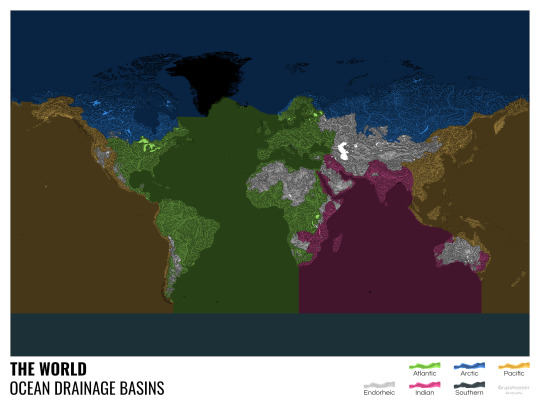
I know from experience that maps can be great conversation starters, and I aim to make maps that are visually striking and can effectively deliver a message. With these ocean drainage basin maps the most important part was to make them easily understandable, so after you have seen one, the others all become effortless to interpret as well. Let me know how I did, I really appreciate any and all kinds of feedback.
Here are a few more from the set, I hope you too learn something new from them. I certainly did, and I am a geographer.
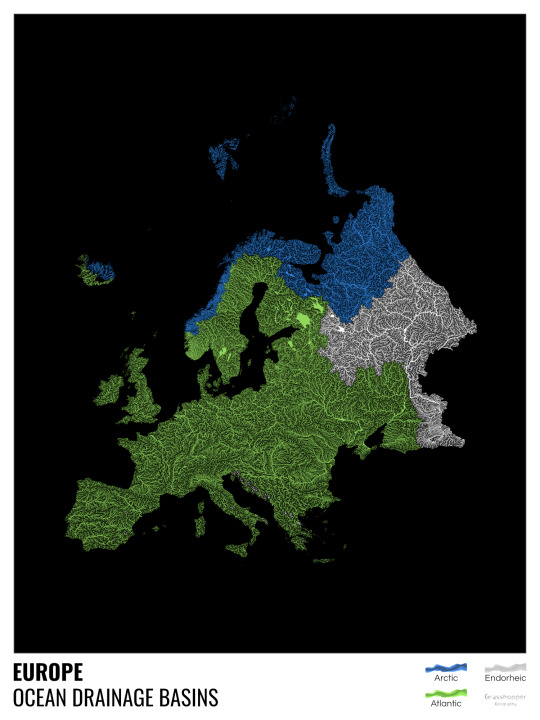
The greatest surprise with Europe is that its biggest river is all grey, as the Volga flows into the Caspian sea, therefore its basin counts as endorheic.
An endorheic basin is one which never reaches the ocean, mostly because it dries out in desert areas or ends up in lakes with no outflow. The biggest endorheic basin is the Caspian’s, but the area of the Great Basin in the US is also a good example of endorheic basins.
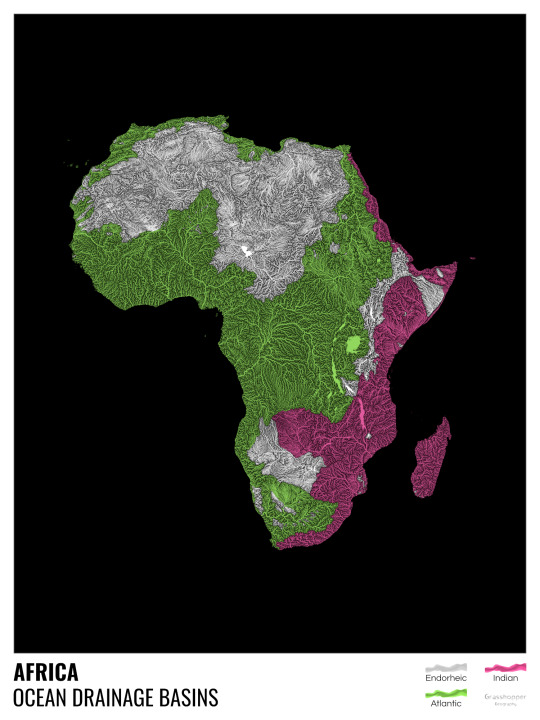
I love how the green of the Atlantic Ocean tangles together in the middle.
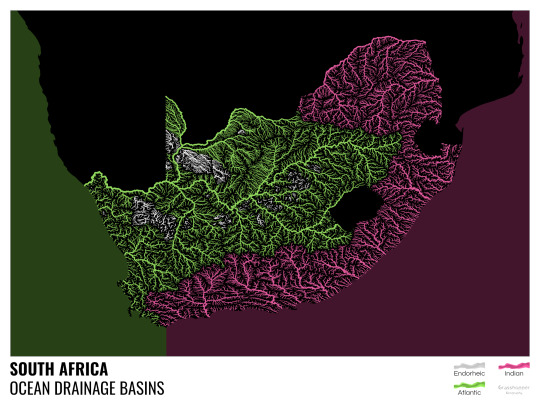
No, the dividing line is not at Cape Town, unfortunately.

I know these two colours weren’t the best choice for colourblind people and I sincerely apologize for that. I’ve been planning to make colourblind-friendly versions of my maps for ages now – still not sure when I get there, but I want you to know that it’s just moved up on my todo-list. A lot further up.

Minnesota is quite crazy with all that blue, right? Some other US states that are equally mind-blowing: North Dakota, New Mexico, Colorado, Wyoming. You can check them all out here.
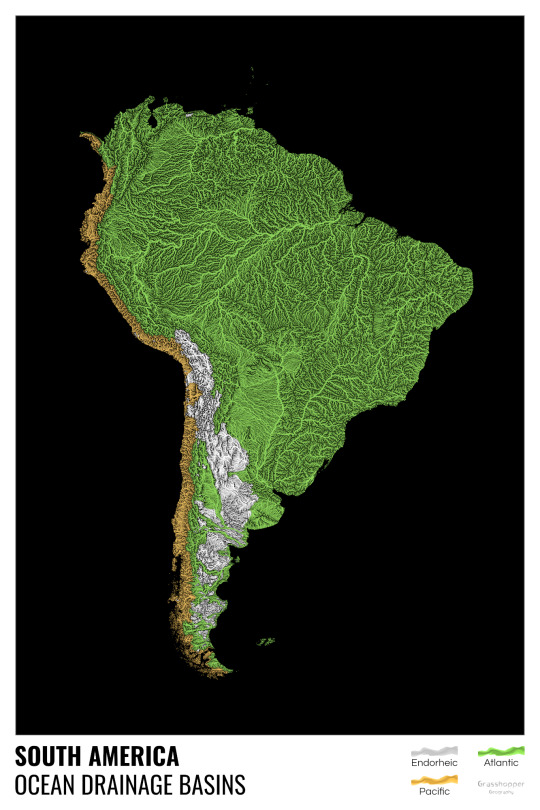
Yes, most of the Peruvian waters drain into the Atlantic Ocean. Here are the maps of Peru, if you want to take a closer look.
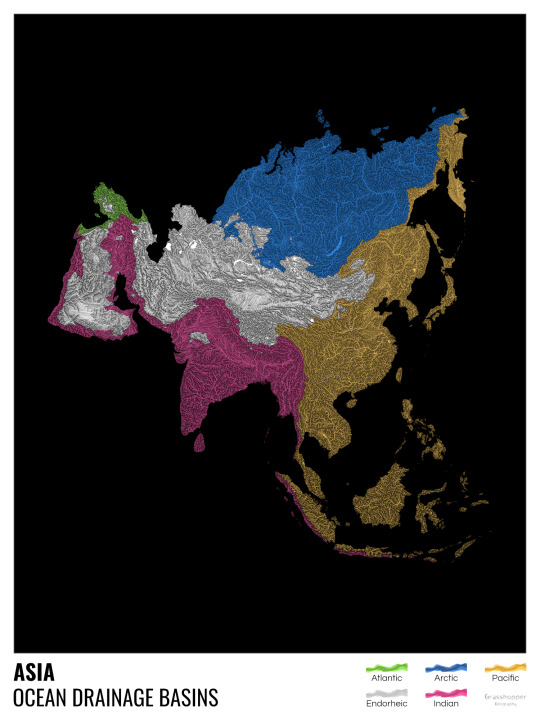
Asia is amazingly colourful with lots of endorheic basins in the middle areas: deserts, the Himalayas and the Caspian sea are to blame. Also note how the Indonesian islands of Java and Sumatra are divided.
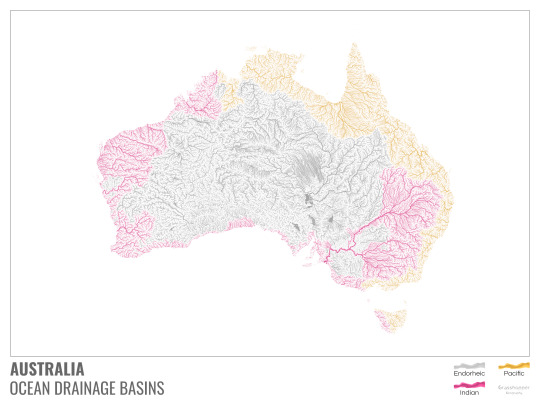
I mentioned earlier that I also made white versions of all maps. Here’s Australia with its vast deserts. If you're wondering about the weird lines in the middle: that’s the Simpson desert with its famous parallel sand dunes.
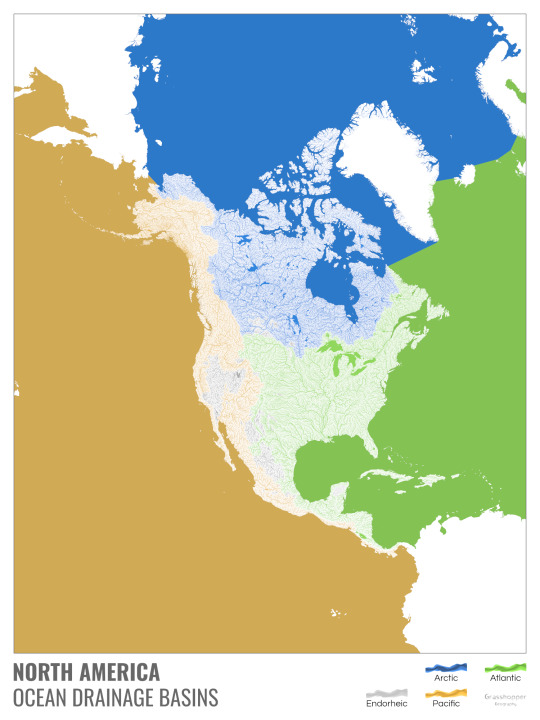
North America with white background and colourful oceans looks pretty neat, I think.

Finally, I made the drainage basin maps of the individual oceans: The Atlantic, the Arctic, the Indian and the Pacific. The Arctic is my favourite one.
I really hope you like my new maps, and that they will become as popular as my river basin maps. Those have already helped dozens of environmental NGOs to illustrate their important messages all around the world. It would be nice if these maps too could find their purpose.
#maps reimagined#geography#cartography#maps#my art#rivers of the world#ocean drainage basins#ocean maps#river maps
16K notes
·
View notes
Text
Gold Turtle Necklace from Ancient Colchis (modern-day Georgia/South Caucasus) c. 450 BCE: this necklace was crafted from 31 turtle-shaped pendants, each one made of g0ld

The necklace was discovered during excavations at an archaeological site in Vani, Georgia (the country, not the state). Ancient Vani once served as the religious and administrative center for the Kingdom of Colchis; as I've previously discussed, Colchis was also known as the homeland of the fabled Golden Fleece, and to much of the ancient world, the Colchians themselves were renowned for their skills in goldsmithing.
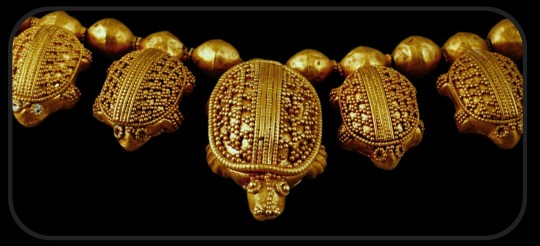
The turtle pendants on this necklace are all decorated with ornate filigree and granulation patterns. The eyes of the 30 smaller turtles were originally made with glass inlay, while the eyes of the largest turtle (seen in the center) were made from drops of gold.
As this article also notes (translated from Georgian):
[This necklace] is unique because of the zoomorphic depiction that it presents. Among the known examples of goldsmithing from antiquity, the depiction of a turtle is not attested anywhere other than the Vani necklace.
The local origin of the necklace is primarily indicated by the stylistic unity of the pendants with other examples of Colchian goldsmithing. It should be noted that the land turtle depicted on the pendants was widespread in Colchis.
The excavations at Vani have uncovered lots of other artifacts made by Colchian goldsmiths. These artifacts include temple ornaments, zoomorphic figures, pieces of jewelry, diadems, headdresses, hairpins, drinking vessels, and appliqués, among other things, and they've provided some really valuable insights into the unique goldsmithing traditions that existed among the peoples of Colchis -- and the myths that evolved as a result.
A few of the other golden artifacts from Vani:
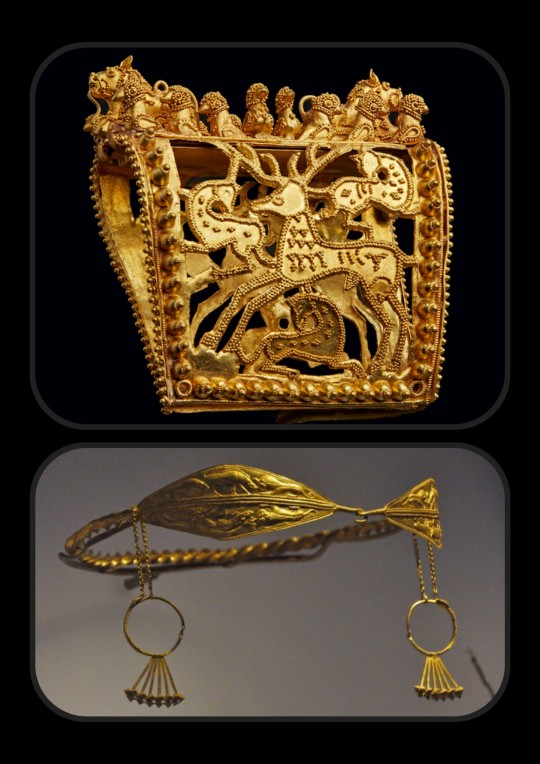
Top: headdress ornament featuring an openwork design, c. 350-300 BCE; the central panel of this piece depicts a stag and three other deer, while the frame is topped by two lions and several rows of birds; Bottom: a diadem with a set of temple ornaments, c. 400-350 BCE; all of the panels along the front of the diadem depict scenes of prey animals being hunted by lions
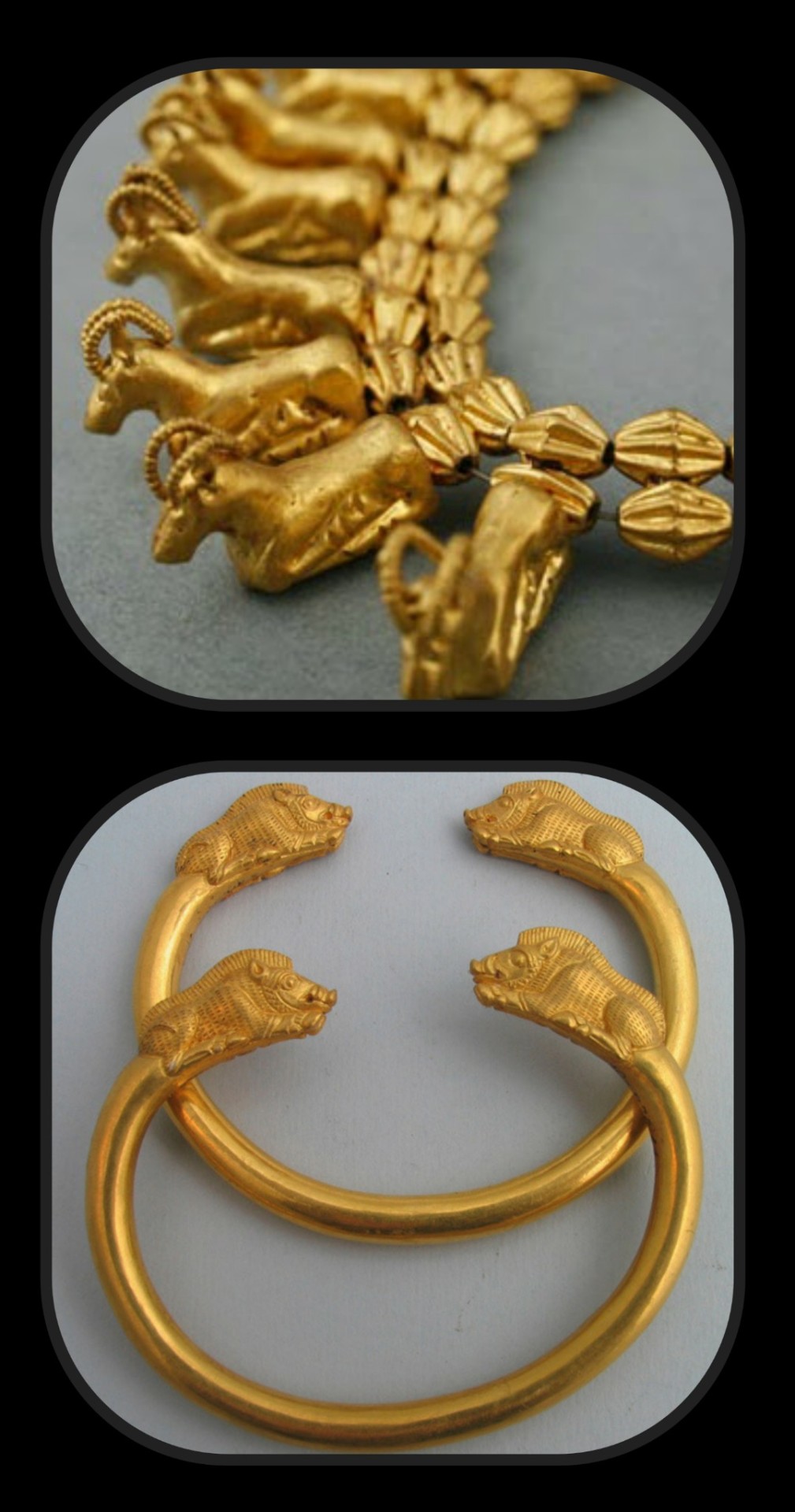
Top: necklace with a series of ram-shaped pendants, c. 400-350 BCE; each pendant was forged from two separate castings that were sealed together to form a complete shape, and the ears/horns were then soldered onto each piece; Bottom: set of bracelets with boar finials, c. 460-440 BCE

Golden appliqués depicting various animals, c. 400-300 BCE

Set of temple ornaments that depict two pairs of riders on horseback, c. 400-350 BCE
And a map showing the location of modern-day Georgia (just for reference):

As this map illustrates, Georgia is nestled right at the crossroads between Europe and Asia, with the Black Sea located on one side and the Caspian not far from the other; it is bordered by Russia to the North and by Turkey, Armenia, and Azerbaijan to the South
Sources & More Info:
National Geographic (Georgian): Golden Kolkheti
Atinati: The Golden Kingdom of Colchis
Smithsonian: Summary of "Wine, Worship, and Sacrifice: the Golden Graves of Ancient Vani" Exhibition
Burusi (Georgian): The Archaeological Discoveries at Vani
Quaternary International: A Modern Field Investigation of the Mythical “Gold Sands” of Ancient Colchis and the “Golden Fleece” Phenomena
#archaeology#history#artifact#ancient history#georgia#sakartvelo#colchis#kolkheti#vani#gold#turtle#jewelry#golden fleece#goldsmithing#south caucasus#mythology#art#applique
2K notes
·
View notes
Note
What part of Russia that you've been to would you say is the most beautiful? I imagine there are many nice places to see
Ooh my favourite area that I've been too is the South—Sochi and the Caucasus. I love mountains! And the sea! All of the things we don't have here. I want to explore more of the area, I want to visit Dagestan and see the Caspian Sea. Unfortunately it doesn't have the reputation of a very safe place, esp. for women.
In the North the farthest I've been is Karelia, which a beautiful, eery place with its rocks and pine trees and moss.
But there are so many places I've never been! I hate that I will never be able to visit them all. For reference, here's a little map of the country's area I've covered during my travels.
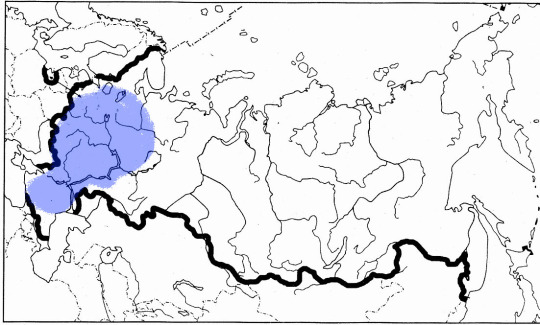
53 notes
·
View notes
Text
I had to stop and cheer this in Prez #5 (love analysing a world map!) but it got funnier and funnier every time I looked.

Canada, Australia and New Zealand are unsafe for USA travel. Based.
On the other hand, most of Europe, Russia and China are apparently safe.
Then you look closer at Europe.

Russia is fine for travel - except for Sakhalin Island and Kaliningrad. (I mean who wants to go to Kaliningrad anyway?)
Someone coloured the Baltic Sea, the Black Sea and the Caspian Sea in as places unsafe to travel.
The European countries unsafe are: Ukraine, Moldova and Albania. Which, okay, but why those three particularly?
Iceland also off limits. Go Iceland.
Hainan in China is off limits. Taiwan is fine to travel to.
Both Koreas still exist and are both too dangerous.
11 notes
·
View notes
Text
Dark Ages Vampire RPG session: our party was setting out on a journey, and the GM had the wonderful idea of copying the period-appropriate Tabula Rogeriana world map to give us as a prop.

There was some funny confusion from players less than familiar with the state of medieval cartography.
"the fuck is that body of water in the middle of the map?"
"Which one? middle right?"
"No, BAHR AL HOZAR"
"The Caspian Sea."
"Trying to read this map gives me a migraine"
"What countries are where?"
"Countries are a modern invention."
"I recognize the word alamanin, that's Germany. Probably."
"Do not try to read the map. That is impossible, instead only realize the truth. There is no map."
Half an hour later, after some highlighted segments had been posted in an attempt to locate our party, one of the players asked "so it's upside down?" and was gently ribbed for not having noticed yet. It's that unreadable. :^D Being upside down is a social construct, et cetera, the mapmaker was an Arab and put Arabia at the top middle. Here is Europe, cropped, rotated, annotated:

Awful, innit? Cutting edge at the time. The NPC who lent it to us was insistent that he wanted it back in good condition afterwards.
And why is Sicily so big? Because this map was commissioned by the King of Sicily.
6 notes
·
View notes
Note
Heyyy, I read your books before and I'd like to know about your creation: Arimight
Arimight. A fictional country in my Prince Series fanfiction – Princess Arimight Collection
Confession: It was created so the author wouldn't have to go through in real life history. Only to realise soon after that the author has to do more researches in order to MAKE the country !!
cons: too much works pros: I get to play goddess !
so, um, it's already kinda iconic now on Wattpad. So I don't think my readers will be happy if I erase Arimight and take Poland or Iceland 😂 OK, I don't want to bore you with the economic and politics. We're probably all bored from the real ones on TV. And so have this headcanons of a fictional Wattpad country 😃😃:
The King has two Queen Consorts. This is a love triangle gone right. They all love eachother and have adopted 6 beautiful princes and princesses. They also have a biological angelic daughter!
There is an old belief that purple is the colour of royalty, golden is the colour of divinity and blue is the colour of rarity and luck. This is only what the older generations said, the younger ones who are tech savvy would joke about their seriousness.
Imagine the Caspian Sea on your Google map image. Then, imagine two lands there. That's Arimight. And now picture a river flowing through Arimight like the Amazon River.
We know many countries actually want Caspian Sea to themselves. Why? The Sea has mineral resources, including oil and natural gas reserves. Your country would be really rich if you have this!!
So now in this fictional world, Arimight produces lots of oils yay! So, very rich baby.
Leaders and influential people would want their children/nephews/nieces to be engaged with the royal children of the King. These people want connection to big money.
Moving on from the economical aspect, the people of Arimight vary from friendliness and cold "you're on your own" personas. It all depends on the seasons in the country. When it's closer to the festivities, the locals tend to be more cheerful. But if it's "Spot Check Day" , they will be more restrained because the police will come to your hometown. They might raid your home, and you can't stop them. It doesn't matter if you're a foreigner or a child. They can, and will, take apart your most treasured items if they catch anything sus.
This is mostly because of the terrorism event taken about 20 years ago. The issue was the high taxes Arimight people have to pay because of the old king.
When the new King, who's now reigning, ascended. He demolished certain laws and made new ones to promote inclusivity and diversity... which was disliked by the traditional members of Arimight.
Now the new king wouldn't be getting any younger any time.soon. he would be reaching 60 in a few more years. Life can be unpredictable. So he has to choose his heir soon.
There are 7 Heirs. And although he had chosen his Crown Prince Roel to ascend when his time comes, there was still doubt lingering the king's mind. Especially since the crown prince had been contacting with the tradition extremist – the king's aunt – who is well-known for loathing foreigners.
As long the king is still breathing, he can still reconsider his choice of heir. But it was certain that the crown prince was most popular, and many of his heirs were reluctant to rule. Not when their royal generation produces too much dark powers all across the globe. Not when the crown prince gaslighted his own siblings, while putting on the perfect Prince Charming show.
The future of Arimight is ever-changing. No wonder 3% of them migrated to safer grounds.
#Prince Series#Princess Arimight Collection#Writing#Fanfiction#Wattpad#Explain#Fictional country#Power#Crown#Greed#Hubris
19 notes
·
View notes
Text
It has not been several days, it has been weeks. Since she left for her long sea journey. Remembering her hint to where to go as well. Her adoptive mother told Blue to head outside the country. She was shown a map in the message, with arrows pointing to where she needed to go.
While she felt detached from her ‘current’ family. She could always trust her adopted mother, who would have her side when she was around. For a Birthday surprise, one of the things she was not expecting was a Big Run. And strangely there was a sense of deja vu as this happened before specifically on her day of birth.
She sees land from the distance and prepares to dock.

When she arrived on the wooden board of the dock, two figures approached her… one of them had a similar ink color to her’s and the other was silver. They were both the same height. But seem to have strikingly different personalities that she was able to judge from their postures. The one in blue was more relaxed, and the other was holding a weapon over their shoulder. It was an Octobrush… but she couldn’t tell which one it was…
But was to tell the moment the silver fellow came charging at her with it while she was weaponless. With a fast forward attempt at a strike. Surprised to see such action. Blue dodged swiftly as a squid and jet propelled herself away, turning into her human form, crashing into the blue Inkling and they both stumbled backward.
“Hermano no puedes presentarte así! Did you want to challenge your long lost sister so badly?” The blue one sighs, as he gets up and helps Blue up.
Sister?
“Mmm, I just thought it would be a fun introduction! I thought people from Inkopolis would like a small quick duel!”
“Can we stop talkin’ for a second?” Blue points at the blue Inkling. “You who are you? And you mentioned a sister?”
“Raine Ortiz. And the one who… wanted to duel you with an Octobrush is my brother Caspian.”
“Raine… and Caspian? And you two were aware of a missing sister?”
“Years ago, there was a Salmonid uprising. I believe, in the Spatlands they’ve been properly named Big Runs. When you were born still as an egg, our mother has been waiting for you to hatch. But we were getting taken over and she wanted you to be safe… so her best option was our trusted sea angel friend should take you somewhere far away and safe.”
Blue was stunned to hear such a thing, she… had parents that really cared about her. And we're willing to give her up to let her live.
“…Raine, I know you said we are related. But I’ve met a lot of people that have ruined my trust. But just to be sure… let’s take a DNA test first.”
1 note
·
View note
Text



“ I remember my wedding, everyone was sort of forced into being my bridesmaid, everyone wanted to make a good impression with my father. All I knew to be true, was that Reed loved me, and wanted to marry me.”
Teagan shared a glass of wine with her Uncle, as the remaining Thornfield gathered together for the unexpected wedding. It was strange to think there weren’t many of them left.
Edmund foolishly failed in underestimating people, but left only one child as his legacy.
Charles the middle child; was on his way to collect his two children Henry & Ingrid.
As for the Sister, who was famously known as Marcus Gazer wife. She died years ago, as did her children.
Charles wanted the whole family together, in a naval wedding. He wouldn’t have the wedding in Wexford or Snow. He wanted something peaceful and natural, the sea pleased both him and his bride.
Princess Olivia, who once had the favor of the king, was now smitten and in love with the second most powerful man in the country. A calculation, Teagan wondered was it a decision Caspian or Charles made.
Charles seemed happy, eager and he was humming. So her suspicious was quite clear, he genuinely was in love with this woman. They were a few days away from the location; a map had already been sent to Teagan and Henry were to meet them. They were late.
Charles was getting anxious, and he could sense something was very wrong. Something was wrong with his children.
“ Teagan, take the small rowing boat, and see what’s going on.” Charles ordered, as he looked back to the boxes that had been untouched. He lowered down, seeing it was a card from Caspian, as he handed it to Olivia. The king was generous; he sent Olivia her wedding dress.
“ Take your husband with you..” Charles ordered after he saw her begin to pack her things alone. “ Your a married woman, act like it.” He tried to hide his temper, Caspian sending a gift was unexpected, and he was troublesome his children were late.
@mistress-alexandria @tishcantavillesblog @caspianmaxson
3 notes
·
View notes
Text
The voyage of the dawn treader: Caspian finds Lucy in the sea.
AU:
The shout of the crew member startled Caspian. He was looking at a map and now he was rushing on the deck beause of the alert “There is someone in the water”.
Without thinking, he jumped to the water and his loyals crewmates followed behind him. As soon as he got ut of the water he heard a scream.
“LUCY!” He turned around and found a pair of black eyes passing by him as if he weren’t there at all. He frowned confused, he was looking at Edmund but Edmund was ignoring him.
“EDMUND!” Caspian looked behind Edmund as Edmund turned around encountering a blond kid splashing on the water like crazy “HELP ME!” A crew member immediately swam towards the kid and Edmund kept calling for Lucy. But where was Lucy?
Caspian turned around and started looking for her too but she was nowhere to be seen; his heart was beating quickly against his ribcage because there was no way he could allow a Pevensy to be lost in his seas.
In their seas, because they were sovereigns in Narnia too and the country was rightfully theirs.
He saw a bronce head go over water and swam towards it immediately, as he was getting closer he recognised it was a girl.
Bronce hair, milky white skin, hazel eyes and freckles that gave her an innocent look. Lucy was here.
“EDMUND!” Lucy shouted and turned towards him “ED...” Her voice stopped as her eyes found his and a smile that kicked the air out of his lungs filled her face with joy “Caspian!” She swam towards him and as she was about to reach him, she went under water; his arm moved on its own as it reached for her and pulled her out of the water towards him. Her small body crashed against his causing a small sound to leave her. He smiled at her just as she looked up to find his eyes.
“Lucy” He muttered and Lucy smiled even more “Welcome back” A giggle came from Lucy and together they swam towards the ship, when they arrived a swing like structure was pushed from the ship and he placed both of them on it “Hold on” He whispered to her as she stood on the wood. His eyes followed the dhape of her body and he frowned.
Lucy Pevensy was a woman now. Her body showed it.
As they were being pulled up, one of Lucy’s hands went to his waist to support herself. Caspian’s wole body tensed up at the touch and he reminded himself how he had known Lucy since she was a little girl.
But she is older thann you, a voice in his head whispered, years older than you.
He shaked his head to shake the tought away and stared at his crew when they were up. He jumped to the ship and stretched his hand towards Lucy who smiling took it as she looked around. A blanket was given to him but he gave it to her: Her clothes were tight against her body and more than one member of is crew was staring.
After giving a sharp look to some of his men, he looked at Lucy and found her eyes not on his face but on his chest. He looked down and found the shirt being see through, he looked at her and a light blush had rested on her cheeks. Contemp, he placed the blanket around her shoulders around her shoulders and the took one for himself while putting one arm around her shoulders.
Better to prove that she was a Queen still.
And he better remind everyone that royals belonged together.
2 notes
·
View notes
Text
In June 2023, when the independent newsletter Kit first published this article, the president of Azerbaijan Ilham Aliyev and Armenia’s Prime Minister Nikol Pashinyan were in closer contact than ever before. They met in Brussels on May 14, in Moscow on May 25, in Chisinau on June 1, and then in Ankara two days later. But even this didn’t seem like enough, and further meetings were scheduled for the later part of summer and fall as the two sides verged, by all appearances, on imminent rapprochement. Yerevan declared it was ready to relinquish territorial claims outside of its internationally recognized borders, and this evidently applied to Nagorno-Karabakh, where the breakaway Republic of Artsakh had been proclaimed by the predominantly Armenian population. The backdrop to these events was the West’s paradoxical reluctance to side with the relatively more democratic Armenia in the conflict against authoritarian Azerbaijan.
This article was written by a Russian international affairs reporter, who chose to remain anonymous for safety reasons in the face of Russian state censorship. The author has long covered the conflict in Nagorno-Karabakh, traveling to Armenia, Azerbaijan, and Nagorno-Karabakh itself, and interviewing ordinary residents as well as officials and diplomats on both sides of the conflict.
How Nagorno-Karabakh came to be contested territory
Armenia and Azerbaijan’s modern-day borders first appeared on the global political map in the early 1920s, as the boundaries of Soviet Socialist Republics under the Soviet Union. Before the arrival of the Bolsheviks, these countries, as well as Georgia, had been at war in a power vacuum left in the wake of the Russian Empire’s demise. Each of those countries had its own interest in expanding its territory. In 1919–1920, for example, Armenia and Azerbaijan fought over Nagorno-Karabakh, a region predominantly populated by ethnic Armenians but surrounded by Azerbaijan’s lands.
Until the Russian Revolution of 1917, Karabakh’s largest city was Shusha (traditionally called Shushi by Armenians), a fortress perched atop of a mountain. Today’s capital of Nagorno-Karabakh, Stepanakert, was built under the Bolsheviks on the former site of the village of Khankendi, 15 kilometers (just under 10 miles) away from Shusha.
The ethnic makeup of local populations had some weight in defining the borders of Soviet republics, but it wasn’t the only factor in the decision-making. The Soviet Union’s planned economy and logistics also played a significant role. In terms of the latter, Nagorno-Karabakh was much better connected to Baku than to Yerevan, since Shusha and Stepanakert both had established eastward roads leading towards Azerbaijan’s territories along the coast of the Caspian Sea. Meanwhile, getting from Karabakh to Armenia involved crossing the mountains. For this reason, in 1936, the region was once again granted an autonomous status, but within Azerbaijan.
This designation could not have satisfied everyone. The region was not entirely Armenian: as of 1970, its population was comprised of both Armenians (80 percent) and ethnic Azeris (18 percent). Meanwhile, Karabakh’s historic capital, Shusha, was almost entirely Azeri-populated. Nagorno-Karabakh also didn’t share any segment of its border with Armenia, from which it was separated by the predominantly Azeri Kalbajar, Lachin, and Qubadli districts.
Karabakh Armenians wanted something greater than mere autonomy within Azerbaijan. In February 1988, the republic’s Council of People’s Deputies asked Moscow to transfer the region from Azerbaijan to Armenia. The Central Committee refused their request, while also describing it as a product of nationalist “provocations,” which duly provoked immediate resentment. Calls to break away from Azerbaijan multiplied in the predominantly Armenian Stepanakert. Protests also erupted across both Armenia and Azerbaijan, with people on both sides demanding opposite outcomes: while one side demanded the transfer of Karabakh, the other insisted it should be left as part of Azerbaijan.
Notably, though (and despite the occasional brawls, and even instances of rape, motivated by interethnic conflict) the main form the Nagorno-Karabakh conflict took at the time was political protests, not war.
Killing for Karabakh
“Since the school was segregated, children don’t talk to each other anymore. They enter the school by two separate entrances. They’re educated differently,” said an assistant principal from the Karabakh village of Tug on Soviet television in 1989, lamenting the breakdown of relations between Armenian and Azeri children in the village.
Before the start of the new school year, the parents had demanded that the school be segregated into two separate sectors. The corridor connecting those spaces was boarded up, so that neither the students nor the teachers from different sides would see each other while at school. Until this happened, there had been no ethnically-motivated conflicts between Armenian and Azeri children. But the political climate in Nagorno-Karabakh had grown extremely tense by the late 1980s.
It would be hard to pinpoint the event that marked a turning point towards war — especially since each side had its own sense of turning points. The British journalist Thomas de Waal, author of Black Garden, a book on the history of the Nagorno-Karabakh conflict, writes that the first people known to have died in the conflict were the two young Azeris killed in a clash with Armenians near the settlement of Askeran. Their deaths prompted the Azeris from the town of Aghdam to march on Stepanakert, intending to “sort out the separatists” there.
A few days later, violence broke out in the coastal city of Sumgait, Azerbaijan. According to the Soviet prosecutors’ figures, 26 Armenians died and another 100 were injured as mass beatings, ethnic pogroms, and killings rocked the city. Azerbaijan has a different version of the events in Sumgait. Senior officials and state-controlled media there claim that the Soviet KGB instigated the anti-Armenian pogroms.
The start of 1990 is known as “Black January” in Azerbaijan. The Soviet military violently suppressed protests in Baku, killing over 100 civilians in the process. The protesters were demanding that the local government resign, accusing officials of failing to protect the Azeris in Karabakh. They also called for Azerbaijan’s independence from the USSR.
After these events, Azerbaijan tried to expel the Karabakh Armenians from the disputed region. In the fall of 1991, it began a blockade of Stepanakert, accompanied by heavy shelling. To the Armenians, this was immediately reminiscent of the 1915 genocide of Armenians in the Ottoman Empire, whose survivors were still living in their midst. These associations reinforced the Karabakh Armenians’ conviction that war with Azerbaijan was inevitable and that the alternative to an Armenian Karabakh was their own exile or death.
In 1992, Yerevan resolved to protect Karabakh Armenians from shelling, using its military to create a 15–20 kilometer (9–12 mile) buffer zone around the region’s main inhabited areas. The width of that so-called “safety belt” was roughly the same as the striking range of the Soviet D-30 howitzers, the most common artillery weapons in both Armenia and Azerbaijan, since both countries had inherited them from the USSR. This signaled the start of the First Nagorno-Karabakh War.
Armenian soldiers entered Karabakh villages with megaphones blaring “Attention, attention” in the Azeri language. In many cases, they told Azeri locals to clear out of their homes within 10–12 hours. The world’s indifference to Azeri people who had to leave their place of birth for Azerbaijan, crossing the snow-covered Murovdag mountain range in search of new homes, is remembered with bitterness in Azerbaijan. Many of these refugees had to cross the mountains on foot. More than 700,000 refugees flooded the cities of Azerbaijan as ethnic Azeris fled not only from Karabakh, but also from Armenia, where their life had become unbearable.
Every Azeri also knows about the Khojaly massacre that took place in February 1992, on the fifth anniversary of the pogroms in Sumgait. The town of Khojaly — to this day the location of Nagorno-Karabakh’s only airport — was populated mostly by ethnic Azeris. When the Armenian army began a siege of the town, its residents started to leave, trying to make their way to the predominantly Azeri town of Aghdam. Around 500 of those civilians perished along the way. Some were shot by the Armenian forces; others froze in the woods before they could make it to safety.
Apart from the Kalbajar, Lachin, and Qubadli districts that lay between Nagorno-Karabakh and Armenia, the Armenian military also invaded the Aghdam, Fuzuli, Jabrayil, and Zangilan districts of Azerbaijan — all to ensure that no projectiles could reach Stepanakert. As a result, the Republic of Artsakh emerged in 1994 as Armenia’s creation, comprised of Nagorno-Karabakh and the territories Armenia occupied in an effort to insulate its capital.
The conflict was effectively frozen, but not resolved. None of the U.N. member countries — not even Armenia itself — would recognize Artsakh as an independent nation. At the same time, Yerevan continued to support the breakaway republic openly, even deploying its troops in the region. The Armenian side insisted that its actions were only ensuring the people’s right to self-determination and did not constitute occupation. From the perspective of international law, however, Yerevan was engaged precisely in armed occupation.
How Azerbaijan gained an advantage
After Artsakh was declared an independent republic, the contested territory’s population shrank from 190,000 during the Soviet period to no greater than 146,000. Meanwhile, the regions of Azerbaijan occupied by Armenia became deserted: their Azeri populations left them and Armenians were not eager to move in.
Baku has often accused Yerevan of ruining the territories it had invaded, but Armenia had never planned to develop them. Its original plan had been to use those districts when bargaining for a legal agreement with Azerbaijan that would solidify Nagorno-Karabakh’s independence from Baku. This was a solution proposed by Armenia’s first president, Levon Ter-Petrosyan, in 1997, when he called for compromise with Azerbaijan but got no support from his fellow Armenians.
In 1994, the Organization for Security and Co-operation in Europe (OSCE) organized, via its Minsk Group, talks for regulating the Karabakh question, with Russia, France, and the U.S. as key participants. But since neither the Armenian side nor Azerbaijan could agree to any compromise, those negotiations went nowhere.
Azerbaijani diplomats interviewed by this author admitted that these negotiations were undermined by the 2004 incident with Ramil Safarov, an Azerbaijani serviceman who murdered an Armenian officer while attending a NATO Partnership for Peace program in Budapest. Although a Hungarian court sentenced Safarov (who was born in Karabakh’s Jebrayil District) to life in prison, in 2012 he was extradited to Azerbaijan, where the authorities not only pardoned him, but also promoted him in rank.
The talks nevertheless dragged on right until 2016, when Azerbaijan tried regaining some of the Armenian-controlled territories by force. Over the four days of fighting in April 2016 (which historians now call the April War), the Azerbaijani military captured only a few elevated points in Karabakh’s Jebrayil district, but in the process made clear that it already had a serious military advantage.
Being an oil state, Azerbaijan had been in a position to increase military spending, and did so 10-fold between 2001 and 2015, when its defense expenditures reached $3 billion. By 2013, its military budget already equalled the entirety of Armenia’s state budget. That money was spent on vast quantities of weapons, including combat drones produced by Turkey and Israel. Still, at first, all this saber-rattling could have been written off as merely trying to strengthen Baku’s bargaining position.
How Baku ceased to believe in diplomacy
In 2018, Armenia’s Velvet Revolution brought the pro-Western politician Nikol Pashinyan into power. Pashinyan — a former staffer of Armenia’s first president Levon Ter-Petrosyan (who advocated compromise with Azerbaijan for the sake of peace) — was against rapprochement with Russia, being also wary of Yerevan’s history of unequal relations with Moscow and the latter’s one-way, top-down communication style. Pashinyan also opposed Armenia’s membership in the Eurasian Economic Union (EAEU).
Once in office, Pashinyan launched an anti-corruption campaign, insisting that Armenia’s main enemy wasn’t Azerbaijan but the corrupt elites inside the country. Russian propagandists were quick to label him “a Soros agent.” Indeed, Pashinyan’s administration, with its liberal and Western-educated members, some of whom “didn’t even speak good Russian,” perplexed Moscow.
Pashinyan’s contribution to the Karabakh question was to insist that, in addition to Yerevan, Baku, and the OSCE Minsk Group, the unrecognized Republic of Artsakh should also be permitted to take part in peace negotiations. This condition was a priori unacceptable to Baku.
Until then, Azerbaijan had gazed upon the new Armenian prime minister with a certain hopefulness, since he was the first Armenian leader who didn’t belong to the so-called “Karabakh clan” — a circle of politicians united by having been born on contested territory (like Pashinyan’s predecessors Serzh Sargsyan and Robert Kocharyan) and reviled by Baku as a “junta of war criminals” who stand in the way of peace. When Pashinyan himself began to criticize Kocharyan and Sargsyan, Azerbaijan took this to be a good sign.
For a while, Baku appears to have trusted Yerevan’s promises made behind closed doors. According to one Azerbaijani diplomat, “The Armenians kept saying, ‘Give us time to strengthen our governance, and then we’ll get serious about regulating [the conflict].’” Ilham Aliyev’s foreign policy advisor Hikmet Hajiyev described a similar dynamic in 2020, saying that the Armenian side “asked for time to familiarize themselves with the negotiating process,” but ultimately eroded the process of conflict resolution with “inconsistent statements.”
In spring 2019, the sides launched a program “for preparing their peoples for peace,” which ultimately came down to a symbolic exchange of journalists. In the background, Pashinyan understood that territorial concessions to Azerbaijan would destroy his approval ratings. Meanwhile, Baku wanted at least some of the occupied territories back. When, in 2019, Pashinyan said the reckless words “Artsakh is Armenia, full stop,” his statement brought the sides one step closer to escalation. Then there was another step: in spring 2020, the new president of the Republic of Artsakh, Arayik Harutyunyan, was inaugurated in the historically Azeri Shusha, instead of Stepanakert.
“Unless there’s progress in negotiations, combat operations can be expected already this summer,” an Azerbaijani politician told me in February 2020. In July, his words were confirmed by a shoot-out on the Armenia–Azerbaijan border. Both sides accused one another of “provocation,” though it isn’t clear who was to blame when an Azerbaijani patrol drove up too close to an Armenian checkpoint and the Armenian side took this as a threat. In the escalation that followed, Azerbaijan lost a general, Polad Hashimov. Then, protesters in Baku burst into the parliament building, demanding forceful measures. The crowds’ unprecedented rage made clear that the Karabakh question troubled them far more than corruption or the lack of civil liberties.
Why Russian peacekeepers didn’t bring peace to Karabakh
On September 27, 2020, it became clear that the “safety belt” Armenia had created around Nagorno-Karabakh against Soviet-era artillery could no longer protect the area. Azerbaijani drones and missiles were pummeling the region and its two historic capitals in Stepanakert and Shusha. At the same time, Azerbaijani infantry and tanks ruptured a defense line in the east of Nagorno-Karabakh, advancing deep into the contested territory. Hearing the news of the Azerbaijani army’s arrival, civilians were hastily evacuating from their homes. Within the first hours of the operation, Armenian villages nearest to the front line had been vacated.
Nikol Pashinyan was constantly on the phone those days, trying to reach Vladimir Putin in the hopes that Russia might intervene in the conflict. Although Pashinyan had learned to be more amenable to Putin over his two years in the prime minister’s seat, Putin wasn’t interested in falling out with Baku. Azerbaijan was a key partner to Russia’s oil-and-gas industry, as well as a country that gives Russia overland access to Iran. (When Russia invaded Ukraine in 2022, Azerbaijan remained an essential intermediary for exporting Russian fossil fuels and refining crude Russian oil for unsanctioned resale to other countries.)
Ilham Aliyev himself, truth be told, was far more congenial to Putin than the Armenian government at the time. The Russian president knew Aliyev’s father, Heydar Aliyev, who served in the Soviet KGB — a background that Putin shared and was therefore comfortable with.
In the end, Moscow invited the foreign ministers of the two countries for peace talks on October 9. But, although a cease-fire was reached, maintaining it proved impossible, and Armenian troops continued their retreat.
Armenia still had some hope in the Collective Security Treaty Organization (CSTO), a Eurasian military alliance that included the six post-Soviet countries with the closest ties to Moscow. In the event of aggression against one of its members, the CSTO could offer it military assistance, but on one significant condition: aggression had to be directed against the claimant country’s sovereign territory. Yet it was Armenia that was violating international law by deploying its troops in Karabakh, on Azerbaijan’s sovereign territory.
Things came to a head in the fall 2020. On November 7, the Azerbaijani army captured Shusha. Realizing that defeat was imminent, the Armenian side evacuated the Armenian population of Stepanakert, and two days later Armenia, Azerbaijan, and Russia was signed a treaty. This provisional document left plenty of room for free interpretations, while compelling the sides to cease fire and allowing Russia to send its peacekeeping troops into Karabakh. Armenia had to relinquish the Aghdam, Kalbajar, and Lachin districts in addition to those the Azerbaijani military had already captured. The treaty marked a defeat for Armenia, but the only alternative was a complete military defeat.
This was a painful loss for Armenians, and on the same night of November 10, an angry crowd burst into the government building in Yerevan. Instead of Pashinyan himself, the enraged protesters only found his wristwatch and cologne. For the next six months, Armenians protested, but the following June Pashinyan once again won the election, which proved that the voters had swallowed the treaty after all, rather than perpetuate a losing war.
As a result, the self-proclaimed Republic of Artsakh continued to exist, now under the protection of Russian peacekeepers. Tensions grew. Aliyev criticized the arrangement with Russia, cautiously at first, but later bringing compulsory language into Baku’s policy documents, to the effect that Karabakh was a “zone of temporary deployment of Russia’s peacekeeping forces” — lest anyone forgot that Russia was supposed to withdraw its peacekeepers after five years.
How the Russo-Ukrainian War brought the West to Aliyev’s side
The years of struggle over Karabakh turned the Azerbaijani government into a staunch adherent of the sovereignty principle, which balances the principle of self-determination in international law. Baku has consistently emphasized that Abkhazia and South Ossetia are Georgian lands, and that Crimea is part of Ukraine. And yet, it was Ilham Aliyev who was first to speak to Vladimir Putin after the Russian president recognized the independence of the Donetsk and Luhansk “republics” (the self-proclaimed “DNR” and “LNR”). Their conversation took place on February 22, 2022 — the day after the fateful meeting of Russia’s Security Council that sanctioned the invasion of Ukraine.
Although Russia’s relations with the West had been worsening since 2014, and practically broke down after February 2022, the international community would be hard-pressed to do anything about the Karabakh question without Russia, whose peacekeepers happen to be the ones on the ground in the area.
Nevertheless, it may very well be the West that gets to preside over the signing of the next Karabakh peace treaty. Judging by the number of meetings held by Armenian and Azerbaijani officials in Russia and abroad (in Washington, Brussels, and Prague), Moscow can hardly be said to have an advantage. To dispose with the Russian peacekeepers deployed in Nagorno-Karabakh, which will become possible by the end of 2024, Baku need only give Moscow a six-month notice. The West is hopeful about settling the question decisively right then, and so is Baku. Moscow, on the other hand, is toying with Armenia’s hopes by trying to defer the question of withdrawing its peacekeepers (together with its influence in the region).
But there’s the rub: while Azerbaijan has free choice of international intermediaries, Armenia does not. And now that Azerbaijan is turning towards Washington and Brussels (who have their own interest in getting Russian peacekeepers out of yet another post-Soviet territory), Yerevan’s prevarications are liable to trigger escalations, like the one that took place in September 2022.
With Russia embroiled in a war with Ukraine, Azerbaijan’s Southern Gas Corridor has become more important to the E.U. and its energy security. Russia’s rapprochement with Azerbaijan is also undesirable to NATO countries. These considerations have trumped the concerns over Azerbaijan’s human rights record — leading the Belarusian Nobel Prize laureate Ales Bialiatski to coin the term “Azerbaijanization” to describe the NATO countries’ tendency to avert their eyes from systemic violations of human rights when it suits their interests.
0 notes
Text
#aFactADay2021
#113: the worlds only two double landlocked countries are Uzbekistan (surrounded by Kazakhstan, Tajikistan, Kyrgyzstan, Afghanistan, Turkmanistan and Toomanystans, each of which are themselves landlocked by Russia, Iran, Pakistan and China - apart from maybe the last one) and Lichtenstein (which is surrounded by Switzerland and Austria which are surrounded by Italy, France, Germany, Czech Republic, Slovakia, Hungary and Slovenia). even uzbekistan touches the caspian and dead seas, so its not really really landlocked. the furthest you can get from the ocean is in the Gurbantunggut Desert in China, only 1600 miles from the West of the Indian Ocean and 1600 miles from the east of the ocean. and 1600 miles from the arctic ocean. see it in this handy map i found lol
0 notes
Text
Old map of Europe up to 43"x 55" antique decor Style Decorative map Vintage map of Europe Antique Europe Map Europe Wall Art wall map by VintageImageryX
19.00 USD
Old map of Europe up to 43"x55" Restoration Hardware Style Decorative map Vintage map of Europe, Antique Europe Wall Map Europe Wall Art
◆ NEED A CUSTOM SIZE ?!?! Send us a message and we can create you one!
◆ D E S C R I P T I O N
An rare and beautiful 1901 map of Europe reproduced from Hammond's Atlas of the World This map covers Europe from Portugal to just east of the Caspian Sea and from Iceland and the Arctic Ocean south to Crete and the Mediterranean Sea including part of North Africa and Arabia. Europe is divided by color. A wonderful map for home, office and or restaurant.
maps make wonderful Gifts
- more of our antique maps you can find here - https://ift.tt/08f2Alq
◆ S I Z E
16" x 20" / 40 x 50 cm
18" x 24" / 45 x 61 cm
24" x 30" / 61 x 76 cm
30" x 40" / 76 x 101 cm
34" x 43" / 87 x 109 cm
43" x 55" / 109 x 140 cm
*You can choose Your preferred size in listing size menu
◆ P A P E R
Archival quality Ultrasmooth fine art matte paper 250gsm
◆ I N K
Giclee print with Epson Ultrachrome inks that will last up to 400 years indoors
◆ B O R D E R
All our prints are without border. But if You need one for framing send me a convo and i'll be happy to leave a small border for framing purposes
◆FRAMING: NONE of our prints come framed, stretched or mounted. Frames can be purchased through a couple of on line wholesalers:
PictureFrames.com
framespec.com
When ordering a frame make sure you order it UN-assembled otherwise you could get dinged with an over sized shipping charge depending on the size frame. Assembling a frame is very easy and takes no more than 5-10 minutes and some glue. We recommend purchasing glass or plexi from your local hardware store or at a frame shop.
◆ S H I P P I N G
Print is shipped in a strong tube for secure shipping and it will be shipped as a priority mail for fast delivery.
All International buyers are responsible for any duties & taxes that may be charged per country.
0 notes
Text
Gold Lion Figurine from Georgia (South Caucasus), c. 2300-2000 BCE: Georgia contains one of the oldest prehistoric gold mines in the world, dating back to about 3400 BCE; researchers also believe that the Greek legend of the "Golden Fleece" was inspired by the goldsmithing traditions found in Georgia

The peoples of Georgia (the country, not the state) have been extracting and processing gold for many thousands of years. Georgia is even home to the oldest known gold mine in the world -- a site known as Sakdrisi, where there is evidence of gold mining operations dating back to about 3400 BCE (roughly 5400 years ago).
Sadly, the prehistoric gold mine at Sakdrisi was damaged (and largely destroyed) in 2014, after a Russian mining company (RMG Gold) was given permission to resume its own mining venture on the site. The full extent of that damage has yet to be determined.
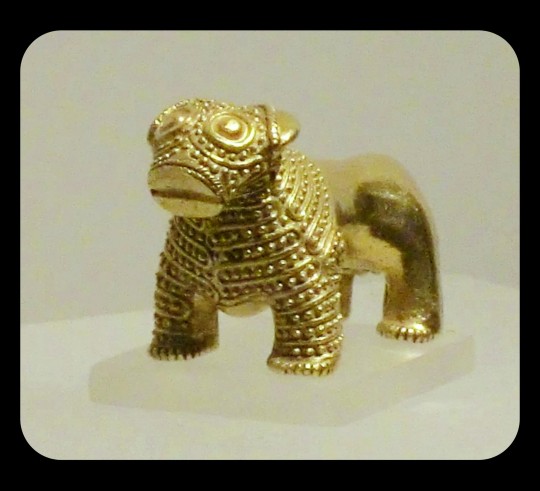
The Tsnori Lion: this figurine dates back to the Bronze Age in Eastern Georgia; it is one of the many artifacts that have come to represent the history of goldsmithing in this part of the Caucasus
The goldsmithing traditions of Georgia also continued to flourish during antiquity, and the ancient Kingdom of Colchis (in what is now Western Georgia) was renowned for both its wealth of gold and its skilled goldsmiths. To the Greeks, Colchis was also known as the homeland of the fabled Golden Fleece -- the treasure sought by Jason and the Argonauts during their mythical voyage into the Caucasus, as described in the Greek Argonautica.
It's believed that the legend of the Golden Fleece may have had at least some basis in reality. Ethnological and historical accounts indicate that the peoples of Colchis/Georgia traditionally used sheepskins to sift for gold in the rivers of the Caucasus; during that process, the fleece would slowly become encrusted with tiny particles of "gold sand," until it eventually took on the appearance of a "golden fleece." Additional research has confirmed that the rich alluvial deposits found within the region certainly would have been sufficient to have produced this "golden fleece" effect.
Researchers believe that those customs may have given rise to the Greek legends about the Colchians and their Golden Fleece -- legends that ultimately evolved into the story of the Argonautica.
The unique goldsmithing traditions of Georgia played an important role in the cultural/political development of the South Caucasus, and those traditions are reflected in the wealth of golden artifacts that have been found throughout Georgia (and elsewhere).

The Location of Modern-Day Georgia: as this map illustrates, Georgia is nestled right at the crossroads between Europe and Asia, with the Black Sea located on one side and the Caspian not far from the other; it is bordered by Russia to the North and Turkey, Armenia, and Azerbaijan to the South
Sources & More Info:
Quaternary International: A modern field investigation of the mythical “gold sands” of the ancient Colchis Kingdom and “Golden Fleece” phenomena
Archaeo Sciences: Bronze Age Gold in Southern Georgia
Britannica: Archaeologists uncover traces of Bronze Age gold workshops in a cemetery near Tbilisi, Georgia
BBC: Artefacts from the world's oldest gold mine
UW Jackson School of International Studies: Georgian environment, heritage at risk as RMG Gold exploits Sakdrisi
UTA Department of Slavic & Eurasian Studies: Ancient Georgia - crossroads of Europe and Asia
Atinati: The Golden Kingdom of Colchis
The Past: Georgia's Treasures: from the Land of the Golden Fleece
National Geographic (Georgian): Golden Lion from Kakheti
Smithsonian: Why this Ancient Civilization Fell Out of Love with Gold for 700 Years
National Geographic's "Out of Eden Walk:" Treasures of the Caucasus
Democracy & Freedom Watch: What was lost when a mining company destroyed the ancient Sakdrisi site?
#archaeology#history#georgia#caucasus#transcaucasia#sakartvelo#artifact#art#lion#iberia#colchis#golden fleece#jason and the argonauts#greek mythology#ancient greece#bronze age#chalcolithic#prehistoric#gold#goldsmithing#conservation#sakdrisi
63 notes
·
View notes
Text
Prologue

It is the early morning of a clear day; the sea stretches like a mirror around the Dawn Treader. Well, as smooth as the sea can be. Here and there a wave – crowned with white foam – breaks at the ship’s bow. About thirty days went by since their departure from Cair Paravel – 400 sea miles, their captain would say. Lord Drinian is Captain of the Dawn Treader since her first launching. It is a proud ship with the golden dragon head on its bow, the looped dragon’s tail at the back and the purple sails. Emblazoned at the top of the fifty-feet-high mast flutters Narnia’s flag. The golden lion on green ground will be seen from far away and announces their arrival. So far, they were anchored in a few harbours along the way. The Duke of Galma even held a tournament for King Caspian. They couldn’t go ashore in Terebinthia due to an epidemic. The last land they set foot on were the Seven Isles. This was a few days ago. Now they are headed for the Lone Islands, the last land mapped in the Eastern Sea. Everyone wonders what may lay behind.
» Good morning, Luna, « Reepicheep hops onto the railing next to a young woman. A smile flickers over her features at the sight of her friend as she returns his greeting.
» This seems to become an interesting day, « he states as he looks out at the sea, taking deep breaths of the fresh salty air. It became a ritual between the two of them to try and predict the events of the awakening day. This is not only entertaining for them but for the rest of the crew as well. Some of the men picked up on this to last through rather uneventful days. To drive away the boredom on such days the two friends sought to learn the one or other handle to sail a ship. The mouse has his difficulties with those because he is too small and doesn’t possess enough strength, but he isn’t going to let that stop him from trying. Nevertheless, many other abilities are given to the Talking Mouse. Reepicheep is one of the most skilled knights of Narnia, even though he is barely two feet tall. Furthermore, his courage is greater than anyone else’s. He belonged to the first to volunteer to become a part of the Dawn Treader’s crew. This ship is the best in Narnia’s rebuilt navy, it is a great honour to have been accepted as a crew member.
In exchange for learning how to sail, Luna and Reep give the more daring crew members sparing lessons in which even King Caspian takes part at times. This doesn’t mean that the men aren’t capable of handling themselves in a fight, but most of them are trained with harpoons, crossbows, and spears. The art of sword fighting is more commonly taught to people of higher status or rank. Luna enjoys those lessons more than anything because they remind her of her responsibilities at home, and they pull the crew together. Usually, she isn’t one for nostalgia and this is no exception. As Caspian told her about his plans to travel east to find long-lost lords, seven friends of his father, she didn’t hesitate to follow him. Years ago, shortly after he was crowned king, the young woman was given the task to watch over his life as his Crown Shield. Even though it isn’t common for women to take up swords, Luna took and still takes her duty very seriously. King Caspian doesn’t always make this easy, but he does his best for his country and people. Reepicheep doesn’t belong to the King’s Guard as he has responsibilities of his own, to lead the Talking Mice. He is a member of the Lion’s Order, though, that means Luna gets to see him often enough around Cair Paravel. Fortunately so, as their friendship goes way back. Memories about their adventures she remembers with a fond smile.
» What are you thinking about? « Asks Reep, nudging her shoulder. He balances on the railing, one arm extended like a tightrope walker – although, so Luna is sure, he wouldn’t need it to help him keep his balance – while the other paw rests on the hilt of his rapier. Step by step, he moves away from Luna. As he turns back around, the red feather attached to the golden circlet around one of his ears bobs up and down. Those accessories give him a daring look. As Luna is about to answer his question, a voice sounds from the crow’s nest.
» Castaways larboard! « The crew hurries over to the left side of the ship to catch a glimpse. Reep and Luna make their way over as well and arrive in time with the king and the captain. Luna gets a spot at the railing and leans over to get a better look. There, a few feet in front of the ship, she makes out three people in the water. They frantically paddle away from the Dawn Treader to not get sucked under the hull.
» Alright, ya two, get in the water, « Drinian orders two men who comply at once. They shrug out of their outer jackets and dive head-first into the blue ocean.
» Prepare tows to get ‘em back up, « shouts the captain, folding his arms in front of his chest and remains his stoical self.
» Hold this, « someone says next to Luna. She whips around to find King Caspian following the example of the two sailors. He shrugs out of his frock coat and hands it, together with his belt and dagger, to a man nearby. Without hesitation he climbs onto the railing and dives in. Immediately, Luna turns her attention down to the water. Caspian emerges from the waves and crawls towards the castaways. She watches him and the surrounding water, but she doesn’t need to worry. The king is always first to help and, thank Aslan, knows how to handle himself. Though, she probably will never cease to be wary of possible dangers. The Dawn Treader glides up to the people in the water. Luna identifies a girl and two boys paddling around. One boy, the blond one, clings to the girl which causes them both to go under several times. Each time they resurface, the boy rattles something and shouts for help, sputtering water in every direction. As Caspian and the two sailors reach them, the king grabs the girl to help her stay above the surface. After she took some deep breaths, she squeals happily,
» Ca-Ca-Caspian! « The voice sounds familiar to Luna. Oh, she got older, but she knows her still.
» Lucy! « Caspian greets her. And that she is, none other than Queen Lucy the Valiant from Narnia’s Golden Age. The crew lowers ropes for the swimmers. Caspian and Lucy are the first to be pulled up.
» Eustace, let them help you! « The other boy shouts. Those dark brown hair are familiar as well. King Edmund the Just seems frustrated but nevertheless delighted to be here – whatever they are doing in the middle of the ocean. As the crew works on pulling them up without letting them bump on the ship’s hull, Luna turns around,
» Bring blankets and something warm for them to drink. « A sailor nods and does as he is told. Meanwhile, Caspian and Lucy arrive on deck. After them, this Eustace fellow is pulled up. Well, the sailor holding the fidgeting boy over his shoulder is pulled up, to be precise. The blond is still complaining about being cold and wanting to talk to a ‘British consul’. All that while he is coughing up water. As soon as the sailor places the boy on the planks he sinks down like a wet bag and becomes still, looking around. Luna doesn’t get to wonder what this British consul might be as Reepicheep leaves her side to see to that situation. The man she sent down to retrieve blankets returns and she rushes to help him carry everything. She grabs some blankets and approaches Caspian who is helping Lucy to her feet. The Queen of Old wrings out her clothes and hair.
» That was thrilling, « she states, and Caspian laughs his typical soft laugh. Lucy joins in and takes in her surroundings. That is when she spots the other female. The beaming smile returns to her lips, and she takes a few steps forward to hug her,
» It’s so good to see you. « Now Luna is wet too, but she couldn’t care less about such trivialities.
» You too, it’s a very pleasant surprise, « she returns the greeting and helps her with the blanket,
» But, by Aslan’s mane, how did you end up here? « As one can hear, the sailor’s slang found its way into her speech during the time at sea. It’s nothing to be ashamed of, the sailors of this crew are honourable men, brave and true friends – or becoming such.
» That’s what I meant to ask as well, « Caspian adds as Lucy nuzzles into the warming fabric.
» I have no idea, « is the only answer they get. Luna turns to Caspian to hand him a blanket as well. He smiles gratefully and gives her a short nod. He is about to put the blanket over his shoulders as a voice calls out to him,
» Caspian! « The king turns around. Edmund grins. The two greet each other with a brotherly hug and Caspian leaves the blanket to the King of Narnia’s Golden Era. Shortly after, they join Lucy and Luna. The latter hands Caspian another blanket as Edmund surprises her by drawing her in for a hug as well. She can’t help but smile at her old friend.
» It seems we’re in for another adventure, « Edmund smirks and she nods along, not holding in a curt laugh.
» Did you call for us again? « Lucy asks Caspian. The king rests one hand on her and Edmund’s shoulders each and shakes his head,
» No, not this time. « He shoots Luna a questioning look. It almost seems as if he expects her to share her thoughts on this. But it’s not her place to speak when the queen and kings are having a conversation. Such things are very strict at court but not strict at all with Caspian on the Dawn Treader. Not that he enforces those etiquettes at court, but it is tradition and people are always hesitant to break with those. Edmund, probably sensing her hesitation, speaks up while drawing the blanket tighter around himself,
» Well, whatever the case, I’m just glad to be here. «
In this very moment, a cry sounds over the deck and everyone whirls around. This Eustace still lays on the planks, Reepicheep balances on this chest but the boy throws him off. The Talking Mouse performs a roll and strides over to the royals, glancing over his shoulder at the boy.
» Reepicheep! « Lucy greets him. The addressed turns at once at the sound of her voice, straightens his belt and bows deeply while lifting his circlet like a hat.
» Your Majesties, « he raises and salutes in the direction of the queen.
» Hello Reep, « Edmund says,
» What a pleasure. « Always the diplomate, isn’t he? Caspian smirks and crosses his arms over his chest. Luna decides to silently observe the scene while enjoying the gentle wind on her face. Wind that never really sleeps at sea. That’s why the men are back at their posts, Drinian shooed them off and returned to the wheel up on the quarterdeck. Some of the crew gathered near the queen and kings, eyeing the three castaways.
» Oh, the pleasure’s all mine, sir, « Reep answers, trying to smooth his damp fur,
» But what are we doing with this… hysterical interloper? « His question is accompanied by a move of his paw in the direction of Eustace. Meanwhile, the blond boy got on all fours and tries to hoist himself up at the railing. His face is distorted, eyebrows knit together in a deep frown.
» This giant rat thing just tried to claw my face off! « He shouts, pointing accusingly at Reepicheep. Luna raises an eyebrow at that behaviour, not liking how the boy talks about her dear friend.
» I was merely trying to expel the water from your lungs, sir, « Reep keeps his voice friendly, quite sweet even. Eustace finally manages to draw himself up. With wide eyes he stares at the mouse.
» It- It talks! « He stutters,
» Did you hear that? I-it… just talked! « One moment, it’s silent. Then, the whole crew laughs out loud causing Eustace to jump.
» He always does, « a sailor points out, shrugging. More laughter follows. The blond boy visibly feels not taken seriously.
» Well, I don’t know what kind of prank this is, but I want to wake up NOW! « He shouts, face flushing red and redder. Reepicheep mumbles something to the queen and kings.
» We aren’t throwing him back in, Ed, « Lucy decides firmly, nudging her brother. Eustace didn’t finish though. He stalks over the deck, glaring at everyone in his way,
» I demand to know, just where in the world am I?! « This must be when Tavros decides that it is enough.
» You’re on the Dawn Treader, « the second ship’s mate steps forward,
» The finest ship in Narnia’s navy. « Eustace turns at the sound of the deep voice. As soon as he lays eyes on the towering minotaur, they go even wider. Just like that, he passes out and collapses on the deck in front of Tavros’ hoofs. That causes the crew to laugh even harder than bevor. Well, it should be granted to them. They work hard night and day. Caspian steps up to the second ship’s mate and views the unconscious boy.
» Was it somethin’ I said? « Tavros asks, his volume a bit lower now. Caspian smirks slightly and shakes his head. It surely wasn’t something poor Tavros said, more like that he – a giant in comparison to the slim boy – talked at all or exists, for that matter. King Edmund once told Luna about their world. In this so called ‘England’ they don’t know of minotaurs, centaurs, dwarfs, talking animals, merpeople and the like, other than in fairy tales. That seems like a very dreary world to her but who is she to judge. At a time, she had never crossed Narnia’s borders, not even once. A lot happened since then.
» Take care of him, will you? « Caspian asks meanwhile, and two men lift Eustace up to carry him to the sick bay.
» Way to make a first impression, « Edmund whispers to his sister. She gives him a pointed look and turns to Caspian expectantly who climbs up the stairs to the quarterdeck.
» Men, « he calls out to claim everyone’s attention,
» Behold our castaways, Edmund the Just and Lucy the Valiant, king and queen of Narnia. « The crew jeers and everyone kneels with bowed heads.
~
Caspian rejoins the others again and steps next to Luna. As she catches sight of Lucy shivering, she immediately gets back to her task to watch over the king – she suspects her duty just stretched out on all three of them and probably this Eustace fellow as well. Bravo.
» You should probably head inside to warm up, Your Majesties, « she suggests, gesturing in the direction of the stairs. Edmund raises an eyebrow at her.
» Really? « He asks and she starts to think that she said something to offend him,
» You’re starting to call us ‘Your Majesties’ again? Come on, Luna. « He smiles at her surprised expression while Lucy giggles. Luna didn’t expect this, she probably should have. However, addressing them by their rightful titles happens out of habit. As it is well known, those die hard. Caspian chuckles and places a hand on her arm,
» She’s right; let’s go inside to change out of those wet clothes. «
» And afterwards, you get a tour of our home at sea, yes? « His suggestion is met with approval from all sides and the thee regents make their way downstairs. Reep and Luna hang back. Reepicheep keeping a distance out of respect, she because her arm tingles funnily.

0 notes
Text
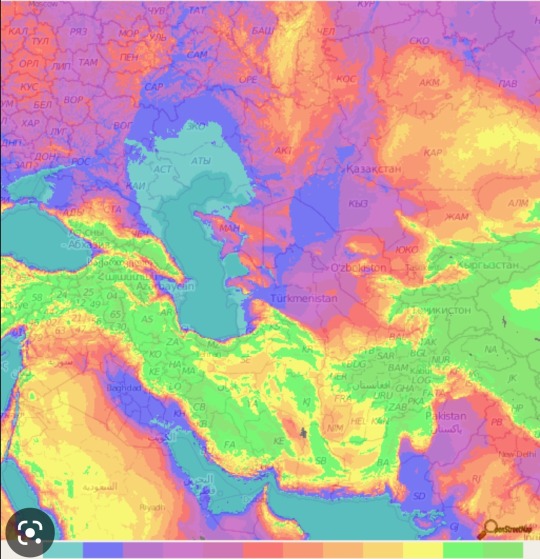
I know this would be the largest geoforming engineering projects ever on the earth.
However if you allowed the depression to be filled and a series of dams locks and dykes. You could recreate the sea in the depression by cutting a channel from the black sea into the caspian sea. Obviously this would be salt water however the environmental impact of increased rain fall in the area would effectively cause the entire region to become capable of sustained farming.
Apprently the depression is around 100m lower than sea level and salt flats.
Making the dessert green and solving the heat impact of other environmental damage from global warming.
The black sea would be reoxygenated the communities in those countries would have access to shipping routes and farming and with the added benifit of de salivation drinking water from that and new rivers and lakes in the area.
Desalination could happen as the water was being divered from the black sea. Huge under taking but the new sea would forever change the lives of millions of people and could even cause drought conditions as far away as China to lesson. It would also lower sea levels.
The engineering would be immense but not impossible.
Just an idea but it could provide a stable environment in that area.
It would cost billions but make trillions.
(Cost annalisist)
It would cool the earth
However water in the desert would be like life on Mars.
Some artificial islands and you could have new communities with farms fisheries and fresh water.
I would need more accuse data to colate
Like evaporation rate of the area of water created.
(Alternative plan be having the desalination in Russia white/kara sea? and pump the fresh water into the volga. Again having locks pumps and flood defence in place and create the worlds largest fresh water lake/sea) if I modeled this right it would actually change the weather patterns and trigger a ice age.
Create a dam round the sea of azov divert the nearby rivers few candidates and remove the salt flats mechanically. As long as the fault line is holds the depression is getting deeper? So would provide water for central aisa and adorning lands.
1 note
·
View note